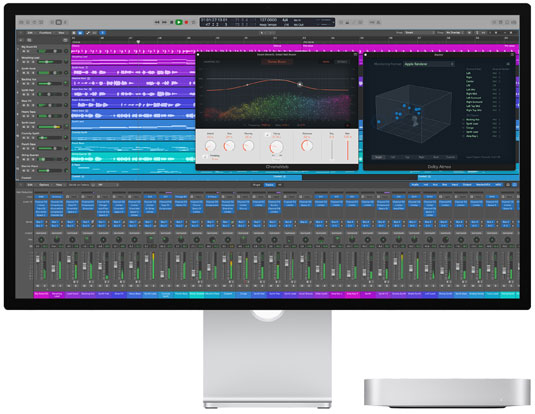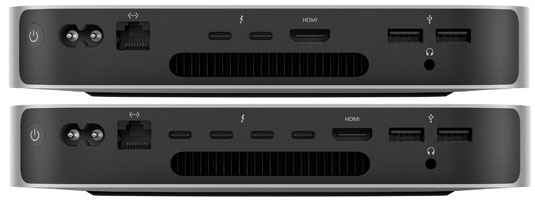Hosted by site sponsor WebMate.
Apple Silicon Mac mini Q&A
Update Published December 3, 2024
All Mac Q&As >> Apple Silicon Mac mini Q&A (Home)
To be notified of new Q&As, sign up for EveryMac.com's bimonthly email list.
What are all the differences between the "M2" and "M2 Pro" Mac mini models? Which is best for my needs?
The "M2 and "M2 Pro" Mac mini models have been discontinued. However, this Q&A has been updated subsequently and can be quite helpful for anyone buying or selling one of these models on the used market.
There are two standard "2023" Mac mini models -- the Mac mini "M2" 8 CPU/10 GPU 2023 and "M2 Pro" 10 CPU/16 GPU 2023 -- as well as a configure-to-order Mac mini "M2 Pro" 12 CPU/19 GPU 2023 with a faster processor.

Photo Credit: Apple, Inc. ("2023 M2/M2 Pro" Mac mini)
Although the "2023 M2/M2 Pro" Mac mini models look nearly identical, there actually are significant external and internal differences. It is important to understand these differences in order to choose the best model for you.
External Differences
The "2023 M2/M2 Pro" Mac mini models both use the same general compact "cuboid" aluminum case design that is 7.75 inches across and deep and 1.41 inches tall. The "M2 Pro" models are 0.2 of a pound heavier, but this is not a noticeable difference and does not especially matter for a desktop system, regardless.
All of these models are essentially sealed and disposable -- the processor, graphics processor, RAM, and storage are not upgradable.
Connectivity Differences
Connectivity is an important difference between the "2023 M2" and "2023 M2 Pro" Mac mini models.

Photo Credit: Apple, Inc. (Top: M2 Ports; Bottom: M2 Pro Ports)
All of these models have two "traditional" USB-A ports, a 3.5 mm headphone jack, default Gigabit Ethernet (with 10-Gigabit Ethernet available as a custom configuration option), 802.11ax (Wi-Fi 6E), and Bluetooth 5.3.
However, the entry-level "2023 M2" Mac mini -- the Mac mini "M2" 8 CPU/10 GPU 2023 -- only has two Thunderbolt 4 ports and an HDMI 2.0 port whereas the higher-end "2023 M2 Pro" models have four Thunderbolt 4 ports and an HDMI 2.1 port.
In addition to support for additional Thunderbolt 4 devices, this means that display support is superior on the higher-end Mac mini models. The entry-level "M2" Mac mini only supports as many as two displays up to 6K whereas the higher-end "M2 Pro" models support as many as three displays, including support for an 8K display via HDMI 2.1, the first time an 8K display is supported on the Mac mini.
Identification Differences
As diligently hand documented by EveryMac.com, the "2023 M2" Mac mini and "2023 M2 Pro" Mac mini have different Model Numbers and EMC Numbers externally on the underside.
These identifiers are unique to both lines and suitable for specific identification, but the Model Identifier in software also is a reliable way to differentiate between these systems and others for the long-term:
| Mac mini | Model No. | EMC No. | Model ID |
| 2023 M2 | A2686 | 8003 | Mac14,3 |
| 2023 M2 Pro | A2816 | 8180 | Mac14,12 |
Additionally, EveryMac.com's Ultimate Mac Lookup feature can uniquely identify all of these Mac mini models by other identifiers.
More information about specific identifiers is provided in EveryMac.com's extensive Mac Identification section.
Internal Differences
Internally, although all of these models have integrated RAM and storage that cannot be upgraded after the initial system purchase, the "2023 M2" and "2023 M2 Pro" Mac mini models otherwise have significant differences.
The entry-level "M2" model -- the Mac mini "M2" 8 CPU/10 GPU 2023 -- has an Apple "M2" SoC with an 8-core CPU/10-core GPU, 8 GB of "unified" memory, and either 256 GB or 512 GB of integrated storage. As discovered in a teardown of this model, if configured with 256 GB of storage, the storage is divided across fewer NAND chips than it is with 512 GB of storage or other options, which results in slower SSD read/write performance for the cheapest option. At the time of initial system purchase, the Mac mini could be custom configured with 16 GB or 24 GB of RAM and 1 TB or 2 TB of storage at additional cost, as well.
The higher-end "M2 Pro" models -- the Mac mini "M2 Pro" 10 CPU/16 GPU 2023 and Mac mini "M2 Pro" 12 CPU/19 GPU 2023 -- have a faster Apple "M2 Pro" SoC with more processor and graphics cores, 16 GB of "unified" memory and 512 GB of integrated storage. At the time of initial system purchase, these models could be custom configured with 32 GB of RAM and 1 TB, 2 TB, 4 TB, or 8 TB of storage. Although they are the same speed in single core tasks, in multicore tasks, these models are roughly 35% and 64% faster than the entry-level option, respectively.
Comparison Chart
The specific differences between processors, architectures, configurations, connectivity, identifiers, and prices for the "2023 M2" and "2023 M2 Pro" Mac mini models are summarized below:
 "2023 M2" |
 "2023 M2 Pro" |
|
|---|---|---|
| Processor Type: | Apple M2 | Apple M2 Pro |
| Processor Cores: | 8 | 10, 12 |
| Graphics Cores: | 10 | 16, 19 |
| Std. RAM: | 8 GB | 16 GB |
| Max. RAM: | 24 GB* | 32 GB* |
| Std. Storage: | 256, 512 GB | 512 GB |
| Max. Storage: | 2 TB† | 8 TB† |
| Ext. Displays: | Two | Three |
| 8K Support: | No | Yes |
| Thunderbolt 4: | 2 | 4 |
| HDMI: | 2.0 | 2.1 |
| Order Number: | MMFJ3LL/A MMFK3LL/A |
MNH73LL/A |
| Model Number: | A2686 | A2816 |
| EMC Number: | 8003 | 8180 |
| Model Identifier: | Mac14,3 | Mac14,12 |
| Intro Price (US): | US$599, US$799 | US$1299, US$1599 |
| Intro Price (CA): | C$799, C$1049 | C$1699, C$2074 |
| Intro Price (UK): | £649, £849 | £1399, £1699 |
| Intro Price (FR): | €699, €929 | €1549, €1894 |
| Intro Price (AU): | A$999, A$1299 | A$1999, A$2449 |
| Intro Price (SG): | S$849, S$1149 | S$1849, S$2303.20 |
* At the time of initial system purchase, the "2023 M2" Mac mini could be custom configured with 16 GB or 24 GB of RAM. The "2023 M2 Pro" could be custom conifgured with 32 GB of RAM. The RAM cannot be upgraded later at all.
† At the time of initial system purchase, the "2023 M2" Mac mini could be custom configured with 1 TB or 2 TB of storage. The "2023 M2 Pro" could be custom configured with 1 TB, 2 TB, 4 TB, or 8 TB of storage. The storage cannot be upgraded later at all.
For pricing information in dozens of other countries, refer to EveryMac.com's Global Original Prices section.
So, which is best for my needs?
Ultimately, ignoring earlier and later models, and keeping in mind that the value proposition may have shifted somewhat on the used market, if price is your highest priority, the entry-level "2023 M2" Mac mini originally was your best option; it was the cheapest new Mac that Apple sold (and is even cheaper on the used market). It is more than fast enough for basic productivity and web use these days and it even is the same speed as the higher-end models in single core tasks.
However, compared to the entry-level option, the higher-end "2023 M2 Pro" Mac mini models are (1) roughly 35% and 64% faster, (2) have twice the RAM by default (and the option of 32 GB of RAM at additional cost at the time of initial system purchase), (3) superior external display support, and (4) two more Thunderbolt 4 ports. For those who can put the extra performance and connectivity to good use, the extra cost of a higher-end model could be well worth it when these models were new and still can be now.
New & Used Mac mini Purchase Options
There are an abundance of places to buy a used or new Mac mini. However, purchasing from a quality business with a solid track record in the Mac market will provide the best experience and save you money and time, too.
In the US, site sponsor Other World Computing sells used and refurb Mac mini models at bargain prices with free shipping, as well. Finally, if you need to sell a Mac mini, A+ BBB-rated Cash for Your Mac will buy your older Mac mini with an instant quote and prompt payment.
In the UK, site sponsor Hoxton Macs sells used Mac mini models with a one-year warranty and free next day delivery throughout the UK.
Please refer to EveryMac.com's Ultimate Mac Comparison feature to dynamically compare any Mac mini model to any other Mac.
Permalink | Report an Error/Typo | Sign Up for Site Update Notices
Suggest a New Q&A | Sign Up for Bimonthly Site Update Notices
<< Apple Silicon Mac mini Q&A (Main) | All Mac Q&As
Established in 1996, EveryMac.com has been created by experts with decades of experience with Apple hardware. EveryMac.com includes, and always has included, original research incorporating detailed, hands-on inspection of packaging, computers, and devices as well as extensive real-world use. All information is provided in good faith, but no website or person is perfect. Accordingly, EveryMac.com is provided "as is" without warranty of any kind whatsoever. EveryMac.com, and the authors thereof, shall not be held responsible or liable, under any circumstances, for any damages resulting from the use or inability to use the information within. For complete disclaimer and copyright information please read and understand the Terms of Use and the Privacy Policy before using EveryMac.com. Copying, scraping, or use of any content without expressed permission is not allowed, although links to any page are welcomed and appreciated.
